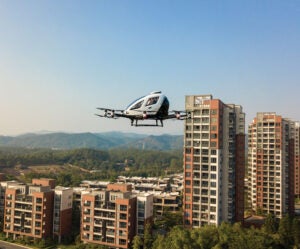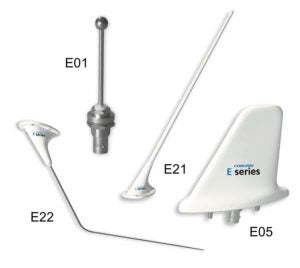
Elsewhere in this issue, we’ve taken a few pages to consider the future of homebuilding, a composite sketch of sorts based on interviews and some raw prognostication. I enjoyed speaking with many people in our industry on this topic, including several who were not directly quoted for the main story, and what I see generally is a continuation of our Experimental world with logical, systemic growth and an increasing need to influence or otherwise bring in a younger audience. All of that is ongoing.
But one topic that interested me was brought to the fore by EAA’s Jack Pelton. He’s very interested in what’s happening on the UAV, or unmanned aerial vehicle, side of the fence. No doubt there is a ton of development going on here, with a lot of the noise coming from companies trying to build what are, essentially, human-carrying drones. These multi-motor devices will depend heavily on onboard stability systems, already arguably proven in drones, ever-improving battery technologies and the constant (if incremental) improvements in motor and power-converter efficiencies. Pelton, along with others, feels that we might just see this overall kind of aircraft show up in the Experimental world, and that alone might be something to really entice “the kids.”
Not to sound like the old guy in the room, but I think we’re getting ahead of ourselves. Think this through. First of all, the FAA has to have a framework for identifying and approving these craft as some form of Experimental. The job has been comparatively easy over the last six or seven decades because the airplanes we put in front of the local FSDO personnel or friendly DAR kinda-sorta look like familiar airplanes. It’s not difficult to look at the control system of, say, an RV-10 and have some idea how moving the stick changes the airplane’s attitude.
But home-drones will all be fly-by-wire, and how do you vet both the design of the system and the application of the actual code? And let’s say some enterprising company has built a prototype and done all the hard work on the software and hardware. What framework will exist for the builder to prove his or her version is exactly like the factory’s and will fly like the prototype ship?
I’m not saying any of this is impossible; it certainly is not. But there’s a lot of work between where we are (manufacturing capability, regs, FAA acceptance) and where we need to be for this to be a viable market segment. And while we should not underestimate the work on our side of the fence, especially do not underestimate the effort socially. One of the nature preserves I frequently walk has prominent signs warning it’s a “no drone zone,” and this has become a common sight in Oregon. In part it’s because of the wildlife aspect of this park, but I’ve seen it elsewhere.
Now imagine your Experimental/Amateur-Built single- or two-seat VTOL. Where will you park it? The idea here is to enable flight from someplace other than an airport. Where will that be? How will your neighbors feel? And even if you do decide to base at an airport, how will this vehicle integrate into the infrastructure? It won’t burn avgas, so the FBOs won’t really care to see you. It’ll need electricity to charge, and that infrastructure has yet to be built around the smaller airports.
Point is: I’m glad that Jack Pelton is excited about this technology and sees it as a growth opportunity for aviation as a whole. And I’m similarly pleased to learn that it’s on his radar. It’ll take a ton of work by the FAA, airport groups and others to make the UAV-like homebuilt reality. I’ll be interested to see how long until we’re ready.

of Experimental-class antennas aren’t TSO’d and are at least 30% less expensive than the ones they look so much like.
Comant Goes E
Another indication of Experimental aviation’s strength in the marketplace is Cobham’s recent jump into our market. Cobham is the parent company of Comant, a longtime aviation antenna manufacturer, and has decided to take on the low-cost, non-TSO’d antenna market. That’s how we get the E series antennas just announced.
For now, it’s four antennas, two for com and two for transponder/ADS-B.
They’ll look familiar, too, as the CI E01 is your typical metal-stick transponder antenna, the CI E05 is a blade-style transponder antenna, the CI E21 is a fiberglass com antenna meant for top mounting, while the CI E22 is the familiar bent-whip com antenna for belly mounting.
Great, fine: How are these different from the Comant versions already on the market? Largely, they aren’t. They’re made on the same production line from the same drawings and the same materials as the TSO’d versions. Only they aren’t subjected to the TSO-specific tests at the end of the process, nor are they put to some of the tests required of the airframe manufacturers who use them as original equipment. (It’s often easier to test everything to one spec, even if only one customer requires it.)
So what’s the benefit? Price. The two com antennas are about 30% less expensive than the TSO’d versions, according to prices current on the Aircraft Spruce website as this is written. (Spruce is one of the big-volume resellers able to order in the large batches that Cobham/Comant are requiring for this new line of antennas.) The E05, equivalent to the CI 105, is half the price, while the E01 stub antenna sells for a mere $28.95, against $153.95 for the CI 101. To me, that sounds about right for the E01. I’m glad to see another traditional manufacturer taking notice of our world and putting product (and choices) into it.
Photos: Courtesy of Ehang and Cobham.














In the event of catastrophic propulsion failure, every single one of these chic and trendy ‘people-carrying drone’ designs will be naught but a smoking hole in the ground. It is the very height of hubris and irresponsibility to attempt to certify them for human carriage.
We are still bound by the laws of physics and aerodynamics! Aeroplanes will glide, and helicopters will autorotate…. what will these chic and trendy designs do???
Multiple engines and or motors (probably minimum of 4-6)- if one fails then the craft auto lands. Seems like a workable solution. I would like to see something like the Urban Aeronautics flyer be made as a kit.
Good point, Keith Helwig! But, I have two words for you: Ballistic Parachute.